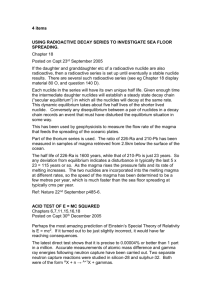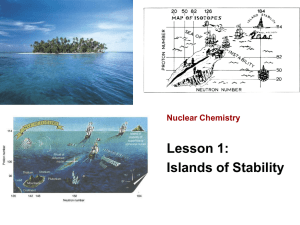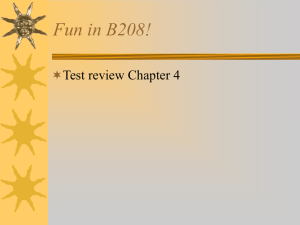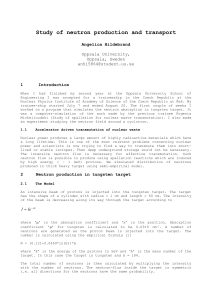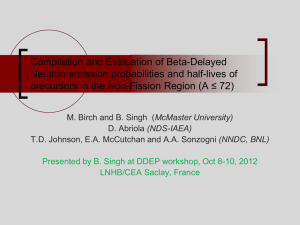Gull_Lake_big_dip_noWillie
advertisement
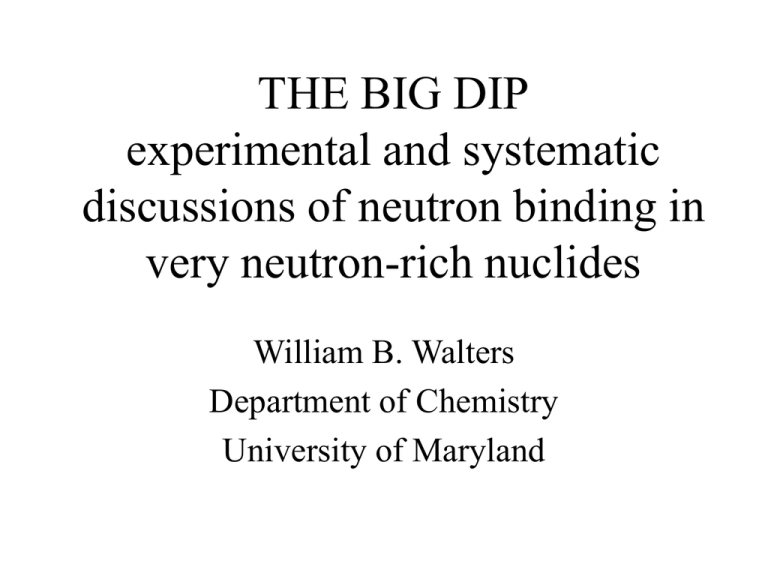
THE BIG DIP experimental and systematic discussions of neutron binding in very neutron-rich nuclides William B. Walters Department of Chemistry University of Maryland • First, let me thank the JINA group for the kind invitation to talk about neutron-rich nuclides here in Michigan at Gull Lake. • It is a real privilege to speak to an audience that includes people who can and and probably will be able to test some of these ideas in future experiments. I am just back at Maryland after a 6-month Sabbatical visit in Mainz that was made possible by a Research Award from the Alexander von Humboldt Stiftung . First, I wish to thank Professor KarlLudwig Kratz, for his efforts with AvH and Mainz that made the visit in Mainz possible, and both he and Gisela for making the visit interesting and enjoyable And, also the U. S. Department of Energy who has provided strong support for the Maryland part of this work. I also must acknowledge the hard work, long discussions, and continuous efforts of BERND PFEIFFER, PETER MÖLLER, DAREK SEWERYNIAK, and ANDREAS WÖHR and a large group of Mainz, Maryland, ISOLDE and Argonne students and post docs, along with many detailed theoretical discussions with both JIRINA RIKOVSKA from Oxford/Maryland and ALEX BROWN from Michigan State. Since BBFH showed in the Figure at the left the connection between elemental abundances the location of closed neutron shells, study and knowledge of the structure and decay of those nuclides involved in nucleosynthesis has been entwined with astrophysical considerations about how, when, and where nucleosynthesis takes place. Reviews of Modern Physics, 29, 47 (1957). 6+ 2140 5± 1847 2+ 4+ 2+ 0+ 1428 1385 613 0 5± 1869 401 4+ 1467 4+ 814 784 652 2+ 2+ 652 0+ 126 124 Cd 48 76 48 645 645 0 Cd 1429 0+ 0 0+ 0 128 130 Cd Cd 78 48 80 48 82 T. Kautzsch, et al., E. P. J. A 9, 201 (2000). 2000 3 calculated 4+ /2+ ratio 2.5 Pd Cd 1500 2 Evidence for shell quenching 1000 Te Te 1.5 Pd 1 Cd 500 calculated 0.5 2+ energies (keV) 0 45 Pd calculations: Kim, Gelberg, Mizusaki, Otsuka, von Brentano, NP A 604,163 (1996). 50 55 60 65 70 75 80 0 85 Monopole shift in odd-mass Sb nuclides. J. Shergur et al., PRC 65, 034313 (2002) 1806 d5/2 Decay of Sn-135 to levels of Sb-135 RILIS (CERN/ISOLDE) 963 832 769 g7/2 851 815 798 724 645 527 491 332 270 282 160 0 0 0 0 0 0 0 0 0 37 0 0 0 0 0 0 54 56 58 60 62 64 66 68 70 72 74 0 g7/2 A = 101 103 105 107 109 111 113 115 117 119 121 123 125 127 129 131 52 0 d5/2 g7/2 d5/2 N = 50 0 76 78 80 133 135 207 82 84 126 K.-L. Kratz, B. Pfeiffer et.al Today, I come from the Kratz,Thielemann, Möller, etc.,school of nuclear astrophysics. The basic assumptions about the r-process that underlie the discussion are that r-process must take place in a neutron-rich environment where: neutron densities must range up to 1027 to produce elements beyond lead, that at some point neutron densities are encountered at the level of 1020-23 to make the peak at A = 130 (at 1027, little would be left at A = 130), the temperature is over 109 K with an appropriate gamma ray flux, during the process equilibrium exists between (g,n) and (n, g) reactions, that the process ends very quickly…termed “freeze-out” and the nuclides left at the end undergo beta decay (with beta-delayed neutron emission) toward the line of stability. In particular, this process produces the “r-only” nuclides like 110Pd, 124Sn, and 130Te. that the yields shown in the abundance curve arise from material that is “waiting” to move on at “freeze-out” and subsequently decays back to stable nuclides with higher Z, that the peaks in the abundance curves arise from material that has accumulated at a “waiting-point” whose forward movement is “slowed down”, that valleys in the abundance curves arise from material where forward movement is quite rapid and, hence, there is little accumulated material to decay toward stability. Now, I want to describe some details about the (g,n) = (n, g) equilibrium that show where and how nuclear structure and decay properties on nuclei play a role in r-process movement. b decay (n, g) (g,n) Kr half-lives 104(46) Sn = 2.5 for 104Rb67…the process moves on. 48 23 15 9 5 ms. Sn = 5.0 2.3 4.5 2.1 4.3 1.9 4.1 1.3 3.4 0.9 2.5 99 100 101 102 103 104 105 106 107 108 36Kr 98 N = 62 63 64 65 66 67 68 69 70 71 72 Waiting points always have even neutron numbers. If the neutron density is larger, the waiting point could move to 106. If the temperature is higher, the waiting point could move to 102. P. Möller, J. R. Nix, and K.-L. Kratz, ADNDT 66, 131(1997). The decay and waiting responsible for the formation of the A = 130 peak is illustrated. What are shown are the half-lives and Sn values for the N = 82 And N = 83 isotones. As you can see, the neutron is unbound in 123Zr, whereas the neutron is rather tightly bound for all of the N = 82 isotones. nucZ lides With these half-lives, “waiting starts at Z = 44, Ru, and increases toward the major blockade in this mass region, 130Cd. N = 83 4 9 I n=1 3 1 1 3 2 227 6 .2 48 C d 130 131 165 6 .2 68 2 .0 Sn (MeV) 46 5 .6 42 2 .0 Sn (MeV) 56 5 .5 117 1 .5 Sn (MeV) 22 5 18 1 .2 Sn (MeV) 34 4 .9 36 0 .7 Sn (MeV) 9 4 .3 8 0 .7 Sn (MeV) 11 4 .2 9 0 .1 Sn (MeV) 41 Nb 123 124 3 .5 3 .4 4 .1 0 .0 8 Sn (MeV) 4 0 Zr 1 2 2 1 2 3 4 .3 3 .6 3 .8 Half life (ms) - 0 .6 Neutron separation 47 A g 129 130 46 Pd 128 129 4 5 Rh 1 2 7 1 2 8 You can also see that below Z = 44, the half-lives are so short that there is very little waiting. N = 82 4 4 Ru 1 2 6 1 2 7 43 Tc 125 126 42 Mo 124 125 201 Half life (ms) 2 .7 Sn (MeV) Energy (MeV) Sn Finally, at 132In, the Sn is sufficiently high Conclusion: The critical values to permit neutron capture to proceed on to from nuclear structure and decay the next waiting point, 135In measurements that are needed are half-lives and neutron separation energies (masses). 12 Neutron Separation Energies The Sn points are Experimental. Separation Energy in MeV 10 8 Observe that there is NO leveling for the Sn nuclides!!!! Zr Kr Ru Sn 6 4 2 0 -2 50 55 60 65 70 75 Neutron Number From Möller, Nix and Kratz, ANDT 66, 131 (1997). 80 85 In particular, it is the flattening of the separation energies for the Zr (and adjacent) nuclides that results in the large dip in yields for the A = 120 region. Heaviest known yrast structures Heaviest known half lives Sn In Cd g 9/2 160 ms 46 ms 56 ms 22 ms 34 ms 9 ms 11ms 3 ms 4 ms 1/2 Ag Pd Rh Ru Tc Mo Nb p Zr Y Sr p 3/2 Rb Kr Br Se f 5/2 As Ge Ga Zn Cu Ni Z N 50 51 52 53 54 55 56 57 58 59 60 61 62 63 64 65 66 67 68 69 70 71 72 73 74 75 76 77 78 79 80 81 82 d 5/2 s1/2 g 7/2 d 3/2 h 11/2 7/2+ 2434 extrapolated 5/2+ 0 91 Zr 51 40 5/2+ 1400 5/2+ 3000 1/2+ 1205 1/2+ 0 97 Zr 57 40 3/2+ 2042 11/2- 2170 7/2+ 2201 7/2+ 2000 1/2+ 1800 3/2+ 1200 3/2+ 1103 7/2+ 1264 11/2- 2268 Adding six more 5/2+ 1654 N = 4 shell d-5/2 neutrons beyond the ten g-9/2 neutrons leads to a neutron skin 1/2+ 331 that inhibits the 11/2- 50(75) binding of the N = 5 3/2+ 0 131 Sn oscillator shell 81 50 h-11/2 neutrons by the N = 3 shell protons. 11/20 121 Zr 81 40 Neutron monopole shifts from Zr-90 to Sn-132 Neutron monopole shifts from Zr-90 to Gd-145 Neutron levels normalized to the d-3/2 particle. Continued addition of g7/2 protons Beyond Z = 50 continues to result in stronger binding for the h11/2 neutron up through Z = 58 extrapolated 11/2- +900 7/2+ +110 3/2+ 0 3/2+ 0 7/2+ -70 11/2- -100 3/2+ 0 7/2+ -500 1/2+ -650 1/2+ -1340 1/2+ -1600 5/2+ -2760 5/2+ -3080 91 40Zr51 97 40Zr57 N = 81 hole nomalized to the d-3/2 hole in Sn-131. 11/2- +1000 5/2+ -2000 3/2+ 0 3/2+ 0 11/2- -50(75) 1/2+ -308 1/2+ -331 11/2- -334 3/2+ 0 3/2+ 0 3/2+ 0 3/2+ 0 3/2+ 0 1/2+ +27 3/2+ 1/2+ -288 11/2- -526 + 1/2+ -283 1/2 -255 11/2- -661 5/2+ -1654 121 7/2+ -2434 Zr 135 40 81 131 133 Te Xe 50Sn81 52 81 54 81 137 56 1/2+ -194 0 1/2+ -110 11/2- -754 11/2- -757 11/2- -754 11/2 -722 139 141 Ba 81 58 Ce 81 60 Nd 81 143 62 145 Sm81 Gd 64 81 Binding of various layers of neutrons by pf shell protons. pf proton core 80 40 90 40 96 40 Zr 40 pf neutron core Zr 50 Zr 56 10 g9/2 neutrons Adding 10 g9/2 protons 132 50 Sn 82 6 d5/2 neutrons little neutron skin 110 40 Zr 70 122 40 Zr 82 8 g7/2 neutrons BIG neutron skin 12 h11/2 neutrons 140 58 Ce 82 Adding 8 g7/2 protons In other words, it takes ALL 18 g9/2 protons to fully bind the 12 h11/2 neutrons. N = 81 hole nomalized to the d-3/2 hole in Sn-131. 3/2+ 0 11/2 -50(75) 1/2+ -331 3/2+ 3/2+ 0 1/2+ -308 0 3/2+ 0 1/2+ -288 1/2+ -283 11/2- -526 11/2- -661 11/2- -334 3/2+ 0 3/2+ 0 3/2+ 0 1/2+ -255 1/2+ -194 1/2+ -110 11/2- -754 11/2- -757 11/2- -754 1/2+ +27 1/2+ +72 1/2+ +111 3/2+ 3/2+ 3/2+ 0 11/2- -722 (749) 5/2+ -1654 7/2+ -2434 In this region as Z increases from 50 to 58, the protons are filling the g 7/2 orbitals, and then from 58 to 64 the protons are filling the d5/2 orbitals. 135 131 133 Te Sn 50 81 52 81 137 Xe 81 56 Ba 81 54 139 Ce 81 58 141 Nd 81 60 0 11/2- -679 (751) 0 11/2- -631 (742) Starting at Z = 65, the protons are filling the s1/2, d3/2, h11/2 orbitals. 143 145 Sm Gd 62 81 64 147 81 Dy 81 66 149 68 The h-11/2 neutrons seem insensitive to h-11/2 protons!! Er 81 13/2+ 2625 5/22004 13/2+ 2713 C2S =4 2+ 1971 9/21915 1/21656 9/21561 h9/2 2+ 5/22+ 9/2 1313 9/212801246 1220 5/21/21083 1/2986 C2S =3 9/29/2 1774 9/21739 2+ 5/21619 + 2 2+ - 1660 1/25/2 13/2+1596 5/2-1575 + 2 9/25/2+ 9/2 13/2 1423 1436 1407 9/2 C2S =6 1/2 9/21355 1306 1283 1/213/2+ 1137 13/2+ 1/2 1423 1082 C2S =6 3/2854 3/2658 3/2601 g7/2 protons 7/2- 0 0+ 7/2133 Sn 134 Te 135Te 1/22+ 9/21677 2+ 9/2- 2+ 1578 9/2- 2+ 1531 1513 9/21397 9/2- 0+ 7/2- 0+ 7/2- 0+ 7/2- 0+ 7/2- 0+ 7/2- 138 140 142 144 Ce 141Ce 13/2+ 3/2984 9/2801 d5/2 protons Ba 139Ba 1/213/2+ 1091 9/213/2+ 3/21035 3/21152 13/2+ 9/2567 136 Xe 137Xe 1846 3/2893 3/2742 3/2662 3/2627 1/2- Nd 143Nd Sm 145Sm h11/2 protons 0+ 7/2146 Gd 147Gd N =83 ISOTONES 0+ 7/2148 Dy 149Dy 0+ 7/2- 0+ 7/2- 150 152 Er 151Er Yb 153Yb 0+ 154 Hf Acta Physica Pol. B 27, 475 (1996). i13/2 1/2- 5/2- p1/2 2340 5/2- f5/2 1770 3/2- p3/2 1442 13/2+ i13/2 7/2- f7/2 i 13/2+ 13/2 2694(200) Sn = 2455 (45) 708 0 f5/2 9/2- p1/2 h9/2 3/2- p3/2 1/2- 7/2- f7/2 2004 h9/2 -1073 207 82 Pb 125 f5/2 2694 2004 1656 p1/2 1656 1561 h9/2 1561 854 p3/2 h9/2 2561 f5/2 1920 p1/2 946 854 i13/2 5000 h9/2 3600 152 50 Sn102 f5/2 0 f7/2 0 normal l2 p3/2 154 f7/2 0 0.7 l2 1850 146 Sn 96 50 p1/2 133 Sn 83 50 9/2- i13/2 3800 f7/2 250 0 0.4 l2 p3/2 -500 9/2+ 3009 9/2+ - 5/2- gap = ~2200 keV 9/2+ - 5/2- gap = ~1500 keV 9/2+ - 5/2- gap •2 000 keV + 9/2 1007 9/2+ 0 9/2+ - 5/2- gap =1700 keV 1/2 588 9/2+ 6000 5/2- 6000 5/2- 3991 New Shell Gap at N = 34??? 1/2- 0 1/2- 1112 5/2- 769 5/2- -694 3/2- -1140 3/2- 0 67 57 Ni Ni 28 39 28 29 3/2- 1095 5/2- 1451 89 40 Zr 49 1/2- 2023 W. B. Walters, Seyssins, France, AIP Conference Series 447, 196 (1998 ). 1/2- 1000 7/2- 0 3/249 0 20 29 Ca 7/2- -2500 7/2- -5500 7/2- -6500 7/2- -7500 3/2- -1000 43 Si 14 29 Possible double magic nuclide 48Si 34 Projected Monopole shift of the p3/2 and p1/2 neutron orbitals with changing nuclear size and N/Z ratio. Conclusion: The “big dip” can be traced to what I believe is a calculated overbinding for the h-11/2 neutron orbitals between N = 70 and N =82. Data exist that can be interpreted to indicate that the binding of h-11/2 neutrons is quite sensitive to the number of g-7/2 ( and by inference, g-9/2 protons) in the nucleus, as well as the number of gdds neutrons present. The challenge for experimental science is to determine as many properties of these very neutron-rich nuclides as possible, and the challenge for theorists is to improve the way that nuclear models describe very neutron-rich nuclides. Stated another way…..RIA must be built with design goals that include the study of Zr-122 and neighboring nuclides. Thank you for your attention. Deformation changes all of that for Sr and Zr by bringing g9/2 protons up from below Z = 40 We start with spherical 98Sr60 where shape coexistence is well known and arises from the 10 neutrons and four protons into downsloping orbitals. And you can see that the nucleus can take another pair of protons for Zr. The important point is that these shifts move 4 to 6 protons from the pf orbitals into the g9/2 orbitals and permit much better binding of the h11/2 neutrons. Adding 10 more neutrons up to N = 70 is seen to be rather neutral and perimts the g9/2 protons to stay up to that point. However, beyond N = 70, additional neutrons drive the nucleus back toward sphericity and drive the protons back into the pf shell, thereby once again loosening the binding for the h11/2 neutrons. Notice that there IS a valley at A = 180…the N = 126 shell works. Heaviest known yrast structures A = 112 N = 1.6 Z A = 124 Sn In Cd g 9/2 Ag Pd Rh r process path Ru Tc Mo N=2Z Nb Zr Y p1/2 Sr Rb Kr p 3/2 Br Se As f 5/2 Ge Ga Zn Cu Ni N 50 51 52 53 54 55 56 57 58 59 60 61 62 63 64 65 66 67 68 69 70 71 72 73 74 75 76 77 78 79 80 81 82 d 5/2 s1/2 d 3/2 h 11/2

